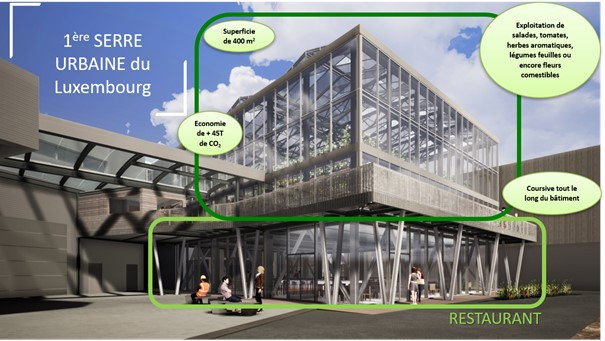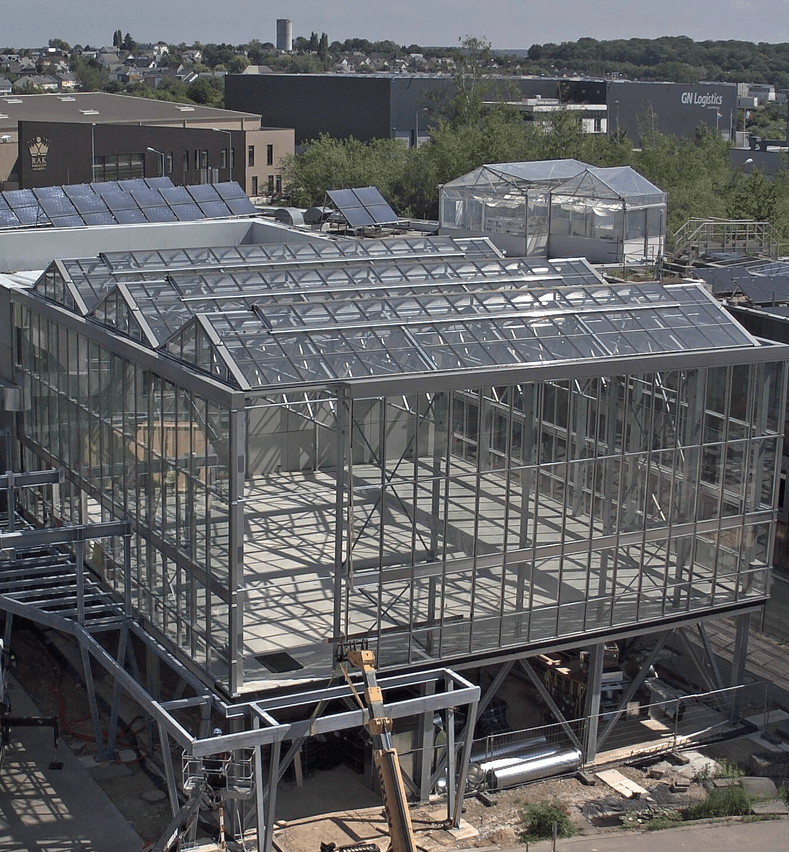About five years ago, the idea of building a greenhouse on the roof of the IFSB was born. This was an innovative project that was very important to Bruno Renders, the director of the IFSB. It has been realised in the construction of Fresh, a two-storey greenhouse of about 400m² with a volume of about 2,700m³, which is currently being finalised. This project is co-financed by the Ministry of the Environment, Climate and Sustainable Development (via the Climate and Energy Fund), as well as by the Interreg North-West Europe (NWE) programme. Other partners, such as Gembloux Agro-Bio Tech - University of Liège, Groupe One, Deforche Construct, Betic Ingénieurs-Conseils, Steinmetzdemeyer architectes urbanistes, Ney & Partners, Neobuild and COCERT are also involved.

The greenhouse has a positive impact on the environment. (Illustration IFSB)
More than just a plastic tunnel under which vegetables grow, Fresh is a real construction whose architectural design was entrusted to Steinmetzdemeyer. It is also a concentration of technology that makes it possible to measure numerous parameters and to interact with the building on which the greenhouse is placed. "There is a real cohabitation between the greenhouse and the building," explains Bruno Renders. "The two interact with each other in a collaborative economy. This greenhouse is a bit of agriculture and a lot of technology!" Because in addition to allowing an above-ground market gardening activity, the greenhouse captures the CO2 emitted by the building thanks to the plants. There is also an exchange of solar energy and with the building's ventilation system. Rainwater is collected, as is organic waste, which is used to produce energy.
"In future, there will certainly be taxes on carbon emissions from buildings. With Fresh, we are anticipating this issue and are already demonstrating that it is possible to reduce these emissions and, consequently, the bill, thanks to a roof-top greenhouse. Such an installation should save 45 tonnes of CO2 per year. It's not much, you might say, but a project like this works through its multiplier effect," says the IFSB director.
The construction of the greenhouse, which is made of steel, was completed in June and the first planting will take place during the summer. During its operation, the greenhouse will also be subject to numerous measurements and studies. “The objective is to show that the greenhouse works technically, but also that it has a sustainable business model, because although there are subsidies for the construction, there are none for the operation. So the greenhouse has to be profitable for it to be sustainable," says Bruno Renders.
The greenhouse is still evolving in terms of its technicality, technology and use. Initially, leafy vegetables and fruit (tomatoes, peppers, heirloom vegetables) and aromatic herbs will be grown hydroponically and operated by a professional (Les Paniers de Sandrine). But the crops can evolve over time and with experience. In the case of Fresh, the vegetables will be used by the company restaurant located just below the greenhouse and will be sold within a short distance of where they were grown. But it would be possible to grow other things, such as functional plants like algae or plants for construction.
If, at first glance, everything seems to fit together to make this proposal the optimal response to the use of a wasted space that is normally a roof, at the legislative level, Bruno Renders acknowledges that "everything is not yet 100% ready, but it is progressing". "It must also be said that setting up the greenhouse in an economic activity zone is less restrictive than in the city centre, which made our task easier. For all that, we have tried to push the paradigms as far as possible, such as allowing a blackout to limit light pollution."
This project is experimental for the moment, but its activation at scale 1 will allow the necessary adjustments to be made, paving the way for a multiplication of the experiment. After having been innovative 20 years ago with a low-carbon building, the IFSB is continuing its pioneering role with this greenhouse project.
